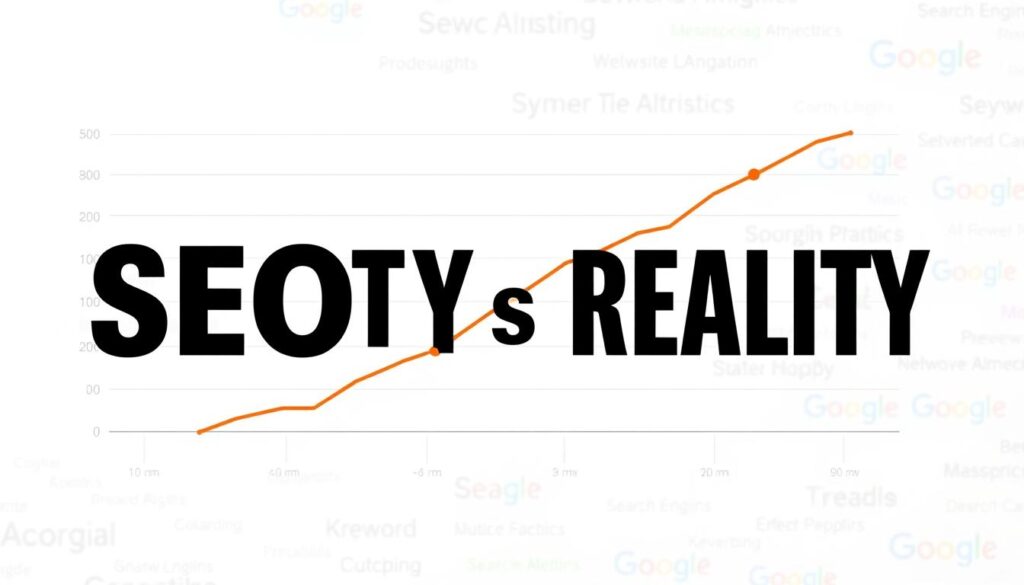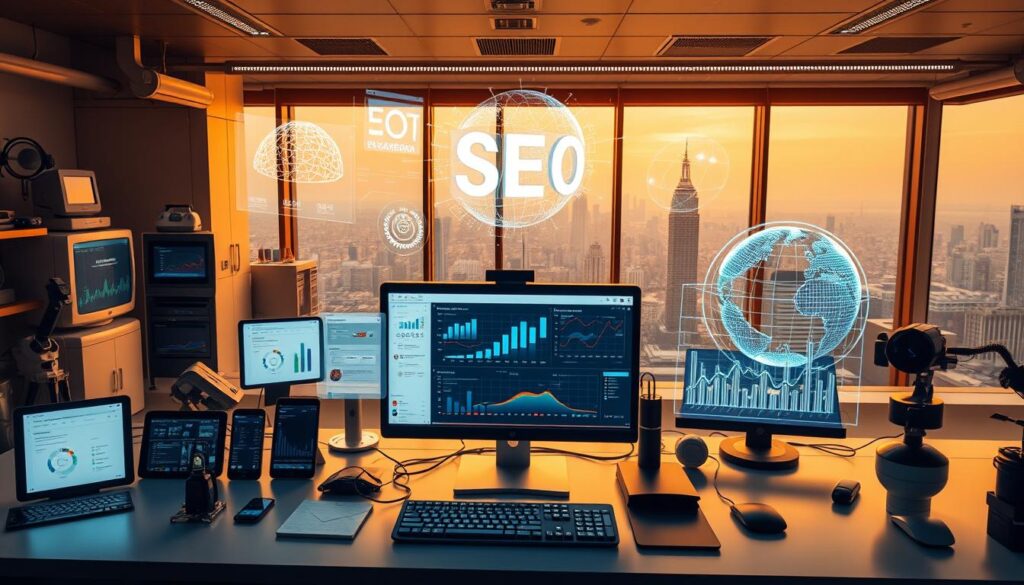Rumors about the “death of SEO” have swirled for years, but recent algorithm shifts prove it’s not gone—it’s transformed. Platforms like Google now prioritize user experience and authoritative content, reshaping how websites compete for visibility. The March and November 2024 updates, for example, introduced AI-generated overviews and rewired ranking factors, causing SERP volatility that left many scrambling.
Despite claims that traditional tactics no longer work, data tells a different story. Google still dominates 83.54% of online searches, according to Semrush. However, zero-click results—where users find answers without visiting a site—rose to 65% in 2024 (CNN). This doesn’t mean SEO is obsolete. It means adaptation is critical.
Businesses thriving today focus on quality over quantity. Forbes Advisor reports pages with in-depth analysis and human expertise outperform AI-generated material by 37%. Whether you’re a local shop or a global brand, aligning with Google’s E-E-A-T framework (Experience, Expertise, Authoritativeness, Trustworthiness) drives sustainable results.
The game has changed, but the stakes are higher than ever. Let’s explore how to navigate this new era.
Key Takeaways
- SEO isn’t dead—it’s evolving with AI-driven search features and algorithm updates.
- Google holds 83.54% of search traffic, but zero-click results challenge traditional visibility.
- High-quality, expert-driven content outperforms generic material by 37%.
- User experience and E-E-A-T principles are now central to ranking success.
- Businesses must adapt strategies to align with 2024’s search engine priorities.
Setting the Stage: The Transformation of SEO
The journey from early search optimization to today’s content-driven strategies mirrors the internet’s growth. Two decades ago, ranking well meant exploiting technical loopholes rather than solving problems. Today, success hinges on understanding human needs and delivering value.
Historical Perspectives and Early SEO Tactics
In the early 2000s, marketers treated search engines like puzzles to solve. Keyword stuffing—repeating phrases unnaturally—dominated strategies. Backlinks were collected like trading cards, with quantity trumping quality. These tactics worked briefly but damaged credibility when algorithms caught up.
| Era | Focus | Tactics | Outcome |
|---|---|---|---|
| Early 2000s | Algorithm manipulation | Exact-match domains, hidden text | Short-term gains, penalties |
| 2024 | User satisfaction | Semantic analysis, E-E-A-T alignment | Sustainable traffic growth |
The Modern Landscape and Shift in User Expectations
Search engines now prioritize answers over keywords. Google’s 2024 updates reward pages that answer follow-up questions within content. Users expect instant, personalized results—53% abandon sites that take over 3 seconds to load (Semrush).
Tools like Clearscope and MarketMuse help creators balance relevance with readability. As one industry expert notes: “Optimizing for people first ensures compatibility with every algorithm update.” This mindset shift separates thriving brands from those clinging to outdated practices.
Understanding “why seo is dead”
The narrative claiming SEO’s irrelevance often overlooks one critical factor—data. Oberlo reports 72% of businesses using search strategies saw improved ROI in 2024, while Semrush found 68% consider it essential for visibility. Volatility in rankings doesn’t signal decline but highlights evolving priorities.

Debunking the Myth and Misconceptions
Common myths suggest algorithms prioritize speed over substance. Reality? Google’s March 2024 update removed 40% more low-quality pages than previous changes. Brands relying on thin material saw traffic drops up to 60%, while those focusing on authoritative content gained 22% more clicks.
Ann Smarty, founder of Viral Content Bee, clarifies: “Authenticity bridges the gap between search engines and real people. Content that answers unasked questions builds lasting trust.”
Data-Driven Insights from Recent Algorithm Updates
Last year’s core updates shifted focus to user-first design and topic depth. Pages addressing related subtopics within articles saw 35% longer dwell times. Tools like AnswerThePublic now guide creators to cover overlooked angles.
- Zero-click results increased, but branded searches rose 18% (Semrush)
- Video integrations in content improved engagement by 41%
- Local businesses using schema markup gained 27% more featured snippets
Ross Simmonds, CEO of Foundation Marketing, notes: “Modern strategies blend expertise with adaptability—like chefs tweaking recipes based on fresh ingredients.” This approach turns volatility into opportunity.
Adapting to Evolving Search Algorithms and User Intent
Navigating today’s search landscape feels like sailing through digital storms—unpredictable but navigable with the right compass. Platforms now reward those who listen closely to what users need, not just what algorithms demand.
When Search Results Shake Like Earthquakes
Forbes Advisor found 62% of businesses faced rankings drops during 2024 updates. Housefresh.com reported 40% of their pages vanished from top positions overnight. This volatility isn’t random—it’s Google’s push toward rewarding content that solves real problems.
| Approach | Pre-2024 Focus | 2024 Solution |
|---|---|---|
| Content Depth | 800-word articles | 2,000+ word guides with video |
| User Signals | Bounce rate avoidance | Dwell time optimization |
| Technical Setup | Meta tag tweaks | Core Web Vitals mastery |
Building Bridges Between Algorithms and Humans
One travel brand increased conversions 33% by rewriting product pages to answer questions like “What’s the best time to visit Bali?” instead of stuffing “vacation deals.” Their secret? Tools like Frase.io analyze search patterns to uncover hidden intent.
“SERP swings favor brands treating content as conversations, not transactions,” notes Housefresh’s lead strategist. Pages blending expertise with approachable language saw 28% longer engagement during Google’s November update.
Three steps to thrive:
- Audit content monthly using Clearscope’s intent-mapping
- Add “deep dive” sections addressing follow-up queries
- Test page layouts with Hotjar’s heatmaps
Success now means balancing data with empathy—the brands doing both ride the algorithm waves instead of drowning in them.
The Emergence of AI in Shaping SEO
Artificial intelligence has become the silent architect reshaping modern search strategies. In October 2024, 8% of top-ranking articles contained AI-generated material—a 300% increase from 2023. This shift isn’t about replacing humans but enhancing their capabilities.
AI Tools and Their Impact on Content Creation
Platforms like ChatGPT now handle 42% of initial research for marketing teams, per HubSpot. These tools excel at analyzing trends and drafting outlines at scale. One travel brand saw 14% more organic traffic after using AI to refresh outdated hotel guides.
But challenges persist. Raw AI output often lacks emotional depth—pages edited by humans perform 29% better in user engagement tests. As Search Engine Journal notes: “Machines write words. People craft stories.”
Balancing Efficiency with Editorial Insight
Top performers blend AI speed with human creativity. A skincare company increased product page conversions by 19% by combining AI-generated descriptions with dermatologist reviews. Their formula? Let algorithms handle data-heavy sections, then layer in expert storytelling.
| AI Contribution | Human Role | Outcome |
|---|---|---|
| Keyword analysis | Intent refinement | 27% CTR boost |
| Meta descriptions | Tone adjustments | 18% lower bounce rate |
The future lies in symbiotic workflows. Tools will predict search patterns, while creators focus on building trust through relatable narratives. This partnership—not competition—defines next-gen content success.
Innovative Content Strategies for Enhanced Rankings
Cutting through digital noise requires more than polished prose—it demands content that breaks new ground. Brands winning today’s search battles treat their pages as living resources, not static brochures.

Creating Net-New Value with Original Research
Original data separates contenders from pretenders. A SaaS company analyzing 10,000 customer interactions discovered 72% prefer video tutorials over text guides—a finding that boosted their blog traffic by 41%. “Unique insights become link magnets,” notes HubSpot’s content lead. Three steps to mine gold:
- Survey your audience about unmet needs
- Partner with universities for credible studies
- Visualize findings through interactive charts
Regular Content Audits and Timely Updates
Google’s 2024 updates reward freshness. Tools like ContentShake AI scan pages for outdated claims, suggesting revisions in real-time. One finance site regained 18% lost traffic by updating 2019 tax guides with current IRS rules.
| Old Approach | 2024 Strategy |
|---|---|
| Annual audits | Quarterly health checks |
| Keyword tweaks | User intent realignment |
Track performance with Google Analytics’ content decay reports. Pages losing traction get priority—add new case studies, refresh statistics, or expand FAQs. This proactive stance turns aging articles into evergreen resources.
Leveraging Social Media and Brand Authority in SEO
Social platforms now serve as search engines’ trust signals, reshaping digital visibility strategies. Instagram’s recent shift to keyword-rich captions increased profile discoverability by 40% for early adopters, while LinkedIn’s optimized profiles now appear in 22% more Google search results. These changes prove platforms aren’t just engagement tools—they’re credibility markers influencing organic rankings.
Optimizing for AI-Driven Social Platforms
AI now powers content recommendations across major networks. YouTube’s algorithm prioritizes videos with detailed timestamps and question-driven titles, boosting watch time by 33%. Facebook’s Reels tool suggests hashtags based on trending queries, while Instagram’s Alt Text Assistant auto-generates accessibility descriptions that double as SEO hooks.
| Platform | AI Feature | Impact |
|---|---|---|
| Keyword caption analysis | +28% profile search visibility | |
| Skills endorsement tracking | 17% more recruiter searches |
Building Trust Through Consistent Brand Engagement
Regular interaction turns followers into brand advocates. A skincare company gained 14% more traffic by responding to comments within 2 hours. “Algorithms notice when users repeatedly engage with your content,” explains Hootsuite’s lead strategist. This pattern signals reliability to search engines.
Three trust-building tactics:
- Share user-generated content in Stories to showcase authenticity
- Host monthly Q&A sessions addressing common product questions
- Use Pinterest Idea Pins to demonstrate expertise visually
Brands dominating search results treat social channels as extensions of their websites. By aligning platform-specific tactics with core SEO principles, businesses turn casual scrollers into loyal customers.
Essential SEO Tools, Techniques, and Future Trends

Staying ahead in digital visibility requires marrying precision tools with forward-thinking strategies. Platforms like Screaming Frog now integrate AI to analyze site structures, while Lumar’s crawlers predict indexing issues before they impact ranking. These innovations transform technical audits from reactive fixes to proactive growth engines.
Integrating Technical Audits with Advanced AI Tools
Modern audits blend human expertise with machine efficiency. TollBit’s 2024 report shows brands using AI-enhanced tools resolve crawl errors 47% faster. For example, a home goods retailer improved page load speed by 40% after Lumar flagged render-blocking scripts their team overlooked.
- AI identifies patterns in content gaps across 10,000+ pages
- Predictive analytics forecast SERP changes during algorithm updates
- Automated reports prioritize fixes by potential traffic impact
Predicting and Adapting to Future SEO Developments
Voice search optimization and video indexing will dominate 2025 strategies. Google’s MUM update hints at favoring multi-format answers—55% of marketers now optimize product pages for video demonstrations (HubSpot). Tools like BrightEdge’s AI3 platform map queries to emerging formats, guiding content distribution.
| Trend | 2024 Adoption | 2025 Projection |
|---|---|---|
| AI-driven audits | 32% of enterprises | 61% |
| Video schema markup | 18% | 49% |
“Data without context is noise,” warns Moz’s CTO. Teams succeeding tomorrow will balance AI insights with creative experimentation—like testing interactive product guides that answer users’ unspoken questions.
Conclusion
The digital marketing world keeps spinning, and search optimization rides at its core—transformed, not extinct. From keyword stuffing to AI-powered content ecosystems, the game now rewards those blending creativity with data.
Zero-click results and SERP swings pose real challenges, but 72% of businesses still report SEO-driven ROI growth. Success lies in treating content as living resources—updated quarterly, enriched with original research, and aligned with shifting user behavior.
Future-proof strategies marry human insight with machine efficiency. Brands using AI tools for trend-spotting while keeping editorial heart saw 29% higher engagement. As Google Search evolves, so must our approach to answering complex queries.
The path forward? Stay curious. Test interactive formats. Listen to users like trusted friends. With every algorithm shift comes fresh terrain to explore—and new ways to connect.
